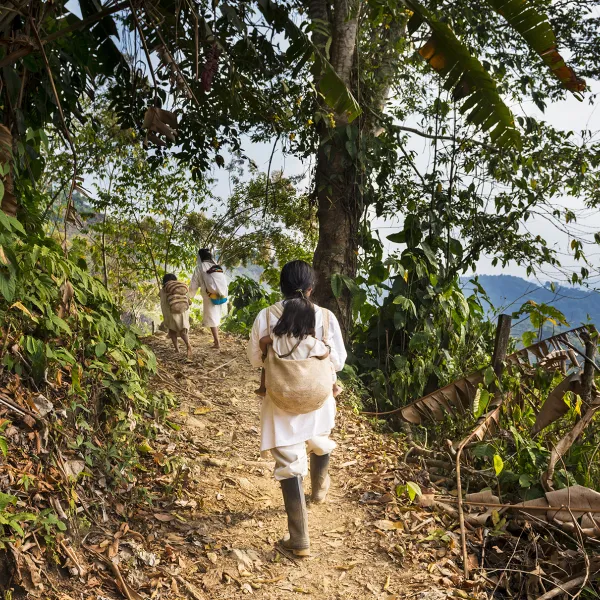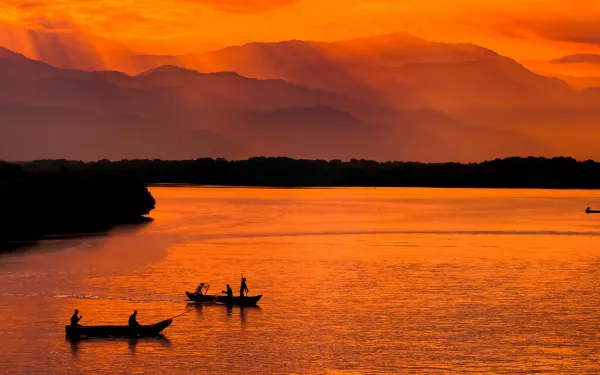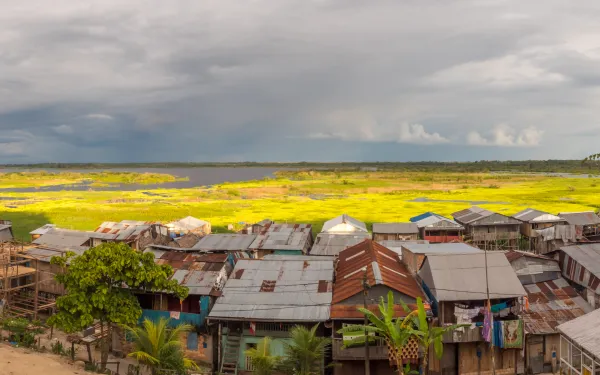
Project
Preserving the legacy of the Sierra Nevada de Santa Marta, Heart of the World
Rising abruptly from Colombia’s Caribbean coast, the Sierra Nevada de Santa Marta reaches 5,775 meters (18,946 ft.) at its highest points, the peaks of Bolívar and Colón. It is the highest coastal mountain system in the world, a place where indigenous knowledge and nature’s own wisdom converge.
The sheer changes in elevation create a wide variety of ecosystems within a small area, where the diversity of plant and animal life creates a unique exuberant region. The melting snows of the highest peaks form rivers and lakes, whose freshwater flows down steep slopes to the tropical sea at the base of the mountains.
The indigenous Arhuaco, Kogi, Wiwa, and Kankuamo people protect and care for this natural treasure with an authority they have inherited from their ancestors. According to their worldview the land is sacred and shared in divine communion between humans, animals, plants, rivers, mountains, and the spirts of their ancestors.
Despite this ancestral inheritance, development projects proposed for the region have failed to take the opinions of these indigenous groups into consideration. The Sierra Nevada de Santa Marta is currently threatened by 251 mineral concessions, hydroelectric projects, agriculture, urban sprawl, and infrastructure projects.
Many of these concessions were granted without the prior consultation of the indigenous communities, which represents a persistent and systematic violation of their rights.
Mining, which implies the contamination and erosion of watersheds, threatens the health of more than 30 rivers that flow out of the Sierra; these are the water sources of the departments of Magdalena, César, and La Guajira.
These threats have brought this natural paradise to the brink of no return. With it, would go the traditional lives of its indigenous inhabitants, who are dependent on the health of their land and the sacred sites it contains.
The Sierra hosts the archaeological site of la Ciudad Perdida, the Lost City, known as Teyuna, the cradle of Tayrona civilization. According to tradition, it is the source from which all nature was born—the living heart of the world.
The four guardian cultures of the Sierra are uninterested in allowing this natural and cultural legacy to disappear.

Related projects

The indigenous resistance, told in their own voice
It’s vital that indigenous and traditional communities have the opportunity to use and strengthen their voices not only to denounce the systematic violation of their rights, but also to share the ancestral knowledge that is key to addressing the current environmental and climate crises. For a variety of reasons, organizations that accompany indigenous struggles, as well as the media and journalists who portray them, often speak on behalf of these peoples. While this intermediary work can help increase the visibility and impact of the frontline defense of territories, there is no better way to hear and understand their stories than from the people who live them. The Intercultural Encounter of Indigenous Communicators represents a step forward in this sense, as it amplifies the work of six indigenous defenders who have made communication a valuable tool for protecting their territories. The project brings together members of indigenous communications collectives from across Mexico, Central and South America to share their experiences defending land, culture and ancestral ways of life. Their stories are of strength and self-determination. Juana Ramírez Villegas, an indigenous woman of the Mixe or Ayuuk people in Oaxaca, Mexico, is part of a communications collective that has enabled coordination between different affected communities and elevated their demands for respect of their territory and defense of their rights to the national level. Together they’re resisting the construction of a massive port and railway infrastructure project across the Isthmus de Tehuantepec known as the Interoceanic corridor. Elvia Bo, a Mayan woman from Southern Belize and part of the organization SATIIM, has kept remote indigenous communities in southern Belize informed of their rights. She is working to install a radio signal powerful enough to reach the many remote indigenous communities of her area through her broadcasting. Her work has been key in confronting repeated attempts by governments and large companies to implement extractive megaprojects within indigenous territory. Laura Brito Boriyu is a member of the Wakuaipa Communication Collective, a group of youth from the Wayúu indigenous community in Colombia. Their communication and audiovisual production skills have served to denounce the impacts suffered for more than 40 years by the Wayúu people in La Guajira as a result of one of the largest open-pit coal mines in the world. Their stories are subverting the heavy investment in propaganda that the company makes while it destroys Wayúu ancestral territory. Mitã Xipaya, a young communicator from the Xipaya people of the Medio Xingu in Altamira, Brasil, is part of the UJIMX collective. They’re denouncing the socio-environmental damages of the Belo Monte megadam, built deep in the Amazon rainforest, which has destroyed not only the natural environment but also the region’s social structure and, particularly, young peoples’ mental health. In that sense, collectives like UJIMX are using communications to motivate youth to envision a better future and work to transform Altamira. Arewana Juruna and Kujaesage Kaiabi are indigenous communicators and filmmakers who live in the Indigenous Territory of Xingú in Mato Grosso, where 16 indigenous communities live and protect the forests of the Xingú river basin. Faced with government policies that favor deforestation, they and other indigenous communicators of the Amazon play a vital role in raising awareness about the need to protect this critical ecosystem. This project has enabled the teams and efforts of these collectives to grow and strengthen. You can read more about each of these indigenous communicators and see the work they produced on the project’s website. They and their people are united by the great history of resistance that indigenous peoples have and continue to show to the current global development model, which prioritizes extractive megaprojects and destructive policies over ancestral knowledge and preservation. Truly understanding their stories and listening to them, from the voices of their protagonists, is fundamental if we as a society wish to move towards a better way of living, in harmony and balance with nature. Preserving the only planet we know from the climate crisis, humanity’s greatest threat, requires incorporating the ancestral knowledge of indigenous peoples in the design and implementation of solutions. This project was spearheaded by AIDA with the support of the Swift Foundation, Tierra Poderosa and organizations that directly support these communities, including the Centro Mexicano de Derecho Ambiental (CEMDA), the Colectivo de Abogados José Alvear Restrepo (CAJAR), the Movimiento Xingú Vivo para Siempre, the Sarstoon-Temash Institute for Indigenous Management (SATIIM), the Unión de Comunidades Indígenas de la Zona Norte del Istmo (UCIZONI) and the União da Juventude Indígena do Meio do Xingú (UJIMX).
Read more
Court suspends fracking pilot projects, reaffirms right to prior consultation in Colombia
A Colombian judge on Thursday suspended the environmental license for the Kalé fracking pilot project and the environmental permitting process for the Platero fracking pilot project—both located in the municipality of Puerto Wilches, Santander—until the consultation processes with the communities of the region are completed. The court ruling responds to an injunction filed by the Afro-Colombian communities of Puerto Wilches (AFROWILCHES), the Podion Corporation, the José Alvear Restrepo Lawyers Collective, and the Colombia Free of Fracking Alliance, to which AIDA provides legal support. For AIDA, the suspension of the projects represents a victory for the communities of the Magdalena Medio. It acknowledges that fracking cannot advance in the country without their real and effective participation, without a social license, and in a context of threats against the lives of defenders who oppose this technique. "The court decision sends a powerful warning message to other Latin American nations,” said Yeny Rodríguez, AIDA attorney. “Governments currently advancing fracking must respect the principles of environmental democracy, especially since this is a technique and an industry that significantly impacts the environment and public health." "While the guarantee of the right to participation and prior consultation is non-negotiable, fracking continues to be a widely questioned technique, which has been banned worldwide due to the lack of scientific certainty about its possible risks and the very high socio-environmental costs it has caused in the countries that already employ it," she explained. There has been a judicial moratorium on the development of commercial fracking in Colombia since November 2018, when the Council of State declared its provisional suspension at the national level. That decision is based on the precautionary principle, since the regulation of fracking does not contemplate the environmental risks and impacts that its application could cause. A final ruling from the Council of State on the fracking regulation is expected in the coming months. In addition, a second appeal for legal protection filed by more than 10 organizations of fishermen, farmers, women and youth of Puerto Wilches is being considered based on the violation of the right to public participation in the implementation of fracking pilot projects there. The appeal was denied in the first instance, but a favorable ruling is expected in the second. The Colombian Constitutional Court will hear of the decisions of these two judicial proceedings. That court and the Council of State will have the final word on the future of fracking’s implementation in the country. The judges of Colombia, and those across the region, have the power and the opportunity to positively transform development models that promote activities like fracking while systematically damaging the environment and violating human rights. Press contact: Victor Quintanilla (Mexico), AIDA, [email protected], +5215570522107
Read more
In Peru, a High Court’s Opportunity to Combat Oil Spills in the Amazon
In 2014, 2500 barrels of oil flowing through the Norperuano Pipeline in the heart of the Amazon leaked in the Cuninico River. For native communities, the consequences of the spill persist to this day, affecting the life and integrity of the people of San Francisco, Nueva Esperanza, Cuninico and Santa Rosa, who are still struggling to find clean water to grow their crops. In 2018, accompanied by the Instituto de Defensa Legal, they filed an injunction (known as an amparo in Peruvian courts) in an effort to prevent further spills, calling for the maintenance of the Norperuano Pipeline. Currently, their case is before the Constitutional Court of Peru, which has an unprecedented opportunity to stop oil spills in the Peruvian Amazon and, with them, prevent the systematic violation of the rights of the indigenous peoples who live there. The Court could do both by ruling in the favor of the petitioners and ordering state-owned oil company Petroperu to perform maintenance on the pipeline. AIDA supported the case with an amicus brief detailing the international obligation of the Peruvian state to guarantee the adoption of the necessary measures—administrative, legal, political and cultural—to protect the rights to a dignified life and a healthy environment. A systematic problem with oil infrastructure Sadly, what happened in the Cuninico basin is not a one-time occurrence; it is a systematic problem facing oil infrastructure in the Amazon. Oil spills in the Peruvian Amazon are putting entire families and communities at risk: compromising food security, contaminating ecosystems, and affecting the cosmovision and ways of life of the Amazonian peoples. According to The Shadow of Oil, an OXFAM report from 2020, 65 percent of the 474 spills that occurred in Amazonian oil fields and from the Norperuvian Pipeline between 2000 and 2019—affecting the territory of 41 indigenous communities—were due to pipeline corrosion and operational failures; only 28 percent were caused by third parties. Complementary data from the Organismo de Evaluación y Fiscalización Ambiental and the Organismo Supervisor de la Inversión en Energía y Minería—both public entities—confirm that, for the most part, oil spills derive mainly from a lack of supervision and oversight by the State and the absence of due diligence by the companies. It’s evident that the responsibility for the vast majority of spills lies with the operating companies. This has generated a structural scenario of threats and violations to the human and environmental rights of Peru’s ancestral populations. Broader causes of the continuous oil spills in Peru include a dependence on the extraction of fossil fuels, the lack of maintenance of facilities, institutional weakness, and gaps in corporate responsibility. Strategic litigation: a way forward The courts in the region have been, on many occasions, valuable actors in the protection of the right to a healthy environment and human rights more broadly. In Colombia, courts have prevented the advancement of several projects that were implemented without prior consultation, affecting the rights of indigenous peoples. In Mexico, courts have recognized the rights of indigenous communities to participate in the use and administration of minerals in the subsoil of their territory. In Ecuador, the Constitutional Court (Ecuador's highest court) ordered the Ministry of Environment to remedy the damages caused by palm oil plantations and to take measures to control and mitigate future and potential damages. Now it’s the turn of Peru’s Constitutional Court to defend these rights by moving to protect the Amazon from future oil spills. Undoubtedly, a positive decision would be an important regional precedent for the protection of the Amazon, an indispensable ecosystem. The Amazon region is majestic. Stretching over 2.7 million square miles, it is the largest tropical forest on the planet and is home to at least 10 percent of known biodiversity, much of it endemic. Since ancestral times, it has been home to more than 470 indigenous peoples, quilombolos and traditional communities; among its trees and rivers you can hear more than 86 languages and 650 different dialects. The Amazon is a vital ecosystem in times of climate crisis. It functions as a large carbon sink that stores between 90 and 140 billion metric tons of carbon dioxide, one of the most important greenhouse gases that, if released, would further accelerate climate change. What happened in Peru highlights the importance of strategic litigation to preserve the Amazon as a key ecosystem to confront climate crisis, and to defend the peoples that call it home.
Read more